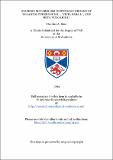Files in this item
Sucrose metabolism in storage organs of 'Solanum tuberosum L.', 'Vicia Faba L.', and 'Beta vulgaris L.'
Item metadata
| dc.contributor.advisor | Davies, Howard V. | |
| dc.contributor.advisor | Wray, John L. | |
| dc.contributor.author | Ross, Heather A. | |
| dc.coverage.spatial | 349 p. | en_US |
| dc.date.accessioned | 2018-06-22T14:25:23Z | |
| dc.date.available | 2018-06-22T14:25:23Z | |
| dc.date.issued | 1994 | |
| dc.identifier.uri | https://hdl.handle.net/10023/14475 | |
| dc.description.abstract | The involvement of the sucrose-cleaving enzymes, acid and alkaline invertases and sucrose synthase in carbohydrate metabolism, was investigated in three different developing sink organs: 1) the starch-storing tubers from Solanum tuberosum L., 2) the starch- and protein-storing cotyledons from Vicia faba L., and 3) the sucrose-storing taproots from Beta vulgaris L. subsp. altissima. In potato, tuberisation is characterised by a change from an invertase- dominated sucrolytic pathway in stolons to one dominated by sucrose synthase in developing tubers. This pathway continues to be the major route for sucrose breakdown during tuber growth but only in tubers receiving a ready supply of photoassimilate. Sucrose flux to the tuber was shown to regulate sucrose synthase activity, excision of developing tubers from the mother plant resulting in a rapid decrease in sucrose synthase activity and an increase in acid invertase. Acid invertase was by far the major sucrolytic enzyme in stored tubers. In contrast, acid invertase does not play a major role in sucrose cleavage in developing bean cotyledons. Sucrose synthase is the dominant sucrolytic enzyme during the early stages of seed growth but in the later stages of development alkaline invertase predominates. During sugar beet development, high acid invertase activity in very young roots declines rapidly when taproot swelling commences, to be replaced by both sucrose synthase and alkaline invertase. Neither enzyme predominates during taproot growth. No significant increase in the activity of any of the sucrolytic enzymes occurred in taproots stored for 80 d at 8°C. Sucrose synthase was purified to homogeneity from bean cotyledons and characterised. Polydonal antibodies were raised to both native and denatured sucrose synthase protein. Similarly alkaline invertase was purified from bean cotyledons and sugar beet taproots and polyclonal antibodies raised to both denatured proteins. Isoforms of bean and sugar beet alkaline invertases were separated by anion-exchange chromatography but were not immunologically distinct. The antibodies produced were used throughout this study to confirm enzyme levels. | en_US |
| dc.language.iso | en | en_US |
| dc.publisher | University of St Andrews | |
| dc.subject.lcc | QK898.S78R7 | en |
| dc.subject.lcsh | Plant physiology | en |
| dc.title | Sucrose metabolism in storage organs of 'Solanum tuberosum L.', 'Vicia Faba L.', and 'Beta vulgaris L.' | en_US |
| dc.type | Thesis | en_US |
| dc.contributor.sponsor | Scottish Office. Agriculture and Fisheries Department | en_US |
| dc.type.qualificationlevel | Doctoral | en_US |
| dc.type.qualificationname | PhD Doctor of Philosophy | en_US |
| dc.publisher.institution | The University of St Andrews | en_US |
This item appears in the following Collection(s)
Items in the St Andrews Research Repository are protected by copyright, with all rights reserved, unless otherwise indicated.

